15 Fascinating Facts in the World of Whiskey
 Whiskey is actually one of the most popular
alcoholic beverages in the world. It has been consumed in every country and on
every continent in the world, including Antarctica. It also cuts across the
classes as it has been consumed in the finest palaces as well as the lowest
slums. With dozens of variations between the true blends and the mixed, there is
a whiskey out there for everybody. Or at least that's how the slogan goes at a
number of the bars. Regardless, the development of whiskey over the years has
become something of its own culture and led to the cultivation of a number of
fascinating facts. Whiskey is actually one of the most popular
alcoholic beverages in the world. It has been consumed in every country and on
every continent in the world, including Antarctica. It also cuts across the
classes as it has been consumed in the finest palaces as well as the lowest
slums. With dozens of variations between the true blends and the mixed, there is
a whiskey out there for everybody. Or at least that's how the slogan goes at a
number of the bars. Regardless, the development of whiskey over the years has
become something of its own culture and led to the cultivation of a number of
fascinating facts.
15) Whiskey is Actually Beer
Whiskey and beer are two distinctive drinks. At
the same time, though, it's important to realize that whiskey is actually beer.
Or rather it was at one point. Whiskey is a form of distilled beer in most
cases. It must go through an extensive filtration process to become whiskey
rather than beer. Supposedly the method for manufacturing whiskey came about in
response to concerns of disease from consuming barley beer. The monks of Ireland
and Scotland created it as a medicine as well as a tonic. They would go through
extensive procedures to ensure that the whiskey was properly filtered. In 1500,
one noted monk named Hieronymus Brunschwygk published a book entitled "Liber de
Arte Distillande." It explained all of the benefits of whiskey and the
importance of distilling alcohol.
Single Malt Scotch Still at the Lagavulin Distillery -
Islay, Scotland:
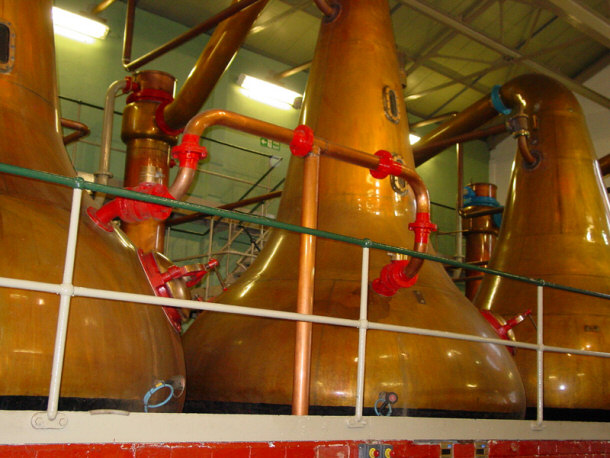
By Finlay McWalter
via Wikimedia Commons
A few types of whiskey aren't distilled beer. It
goes on to state that the culture surrounding the purity of whiskey and its
origins is a strong one shared throughout Ireland, Scotland, Australia and a few
other countries. Most whiskeys are made from the old recipes that the monks and
apothecaries used to use. However, unlike in the olden days, you don't have to
have a doctor's prescription to obtain a bottle today. Both Bourbon and
Tennessee whiskeys use hops rather than beer.
Rack House for Maturing Jim Beam Bourbon Whiskey in
Clermont, KY:
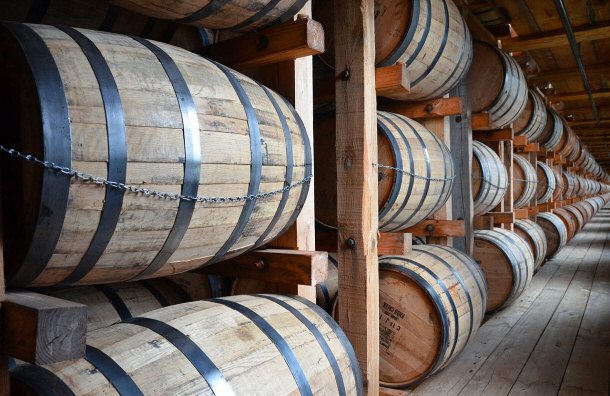
By Bbadgett
via Wikimedia Commons
This changes the recipe
significantly, but the reason for the hops is that it helps to better promote
the yeast contents.
14) Whiskey Has One of the Highest Taxation Rates in the World
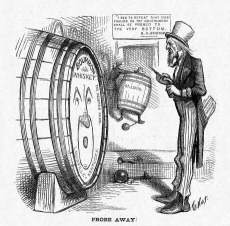 According to
Tax World, whiskey is one of the highest taxed items in the world. In some
countries, it can be taxed as high as 73% a bottle. In the United States, the
tax rate actually falls in at around 50% of the actual purchase price. This is
not just for the federal taxes of course but many other levels of taxation. It
includes a number of other taxes such as state tax as well as other fees. While
the sin tax has fallen out of favor in the public, the government still likes to
keep it around because it's a handy way to bring in extra funds. Whiskey is one
of the most popular of the spirits, and it is likely to remain that way. It is
not popular just for its effects. It has its own culture, and knowing how to drink whiskey is one of the ways to
demonstrate your sophistication and maturity. According to
Tax World, whiskey is one of the highest taxed items in the world. In some
countries, it can be taxed as high as 73% a bottle. In the United States, the
tax rate actually falls in at around 50% of the actual purchase price. This is
not just for the federal taxes of course but many other levels of taxation. It
includes a number of other taxes such as state tax as well as other fees. While
the sin tax has fallen out of favor in the public, the government still likes to
keep it around because it's a handy way to bring in extra funds. Whiskey is one
of the most popular of the spirits, and it is likely to remain that way. It is
not popular just for its effects. It has its own culture, and knowing how to drink whiskey is one of the ways to
demonstrate your sophistication and maturity.
One of the surprising realities, though, is that governments do not tax
whiskey because they want people to stop drinking it. Regardless of what they
say, they tax it because they know people won't give it up. It's the same thing
with taxes on cigarettes. The government would be short significant revenue if
the taxes on whiskey and other alcohols were ever to go away. Additionally,
according to "Tax News," taxes on whiskey, alcohol, and cigarettes are one of
the easiest taxes for the government to raise. While there are lobbyists in D.C.
who protest such raises, they are not nearly so vocal as the lobbyists and
special interest groups in other demographics.
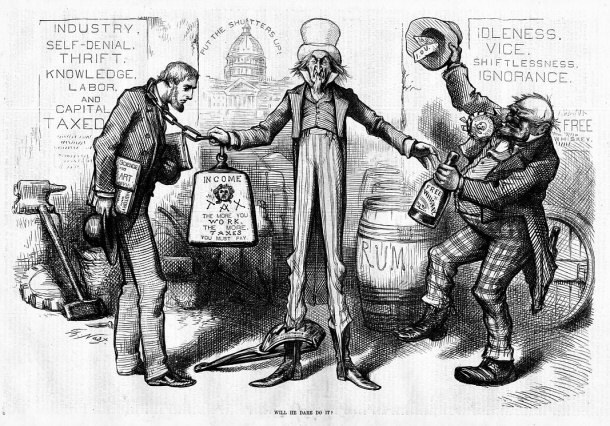
What adds to this irony is that originally, whiskey had no tax whatsoever in
the United States. Even under King George III, whiskey did not receive a tax.
Most of the time, the farmers and townspeople made whiskey themselves when they
had leftover grain. In fact, for a time in colonial America, whiskey was used as
a form of bartering currency, and it was quite valuable too given its believed
medicinal properties.
13) Barreled Whiskey Evaporates
According to the American Distilling
Institute, every barrel of whiskey evaporates at least 3-4% each year that the
whiskey is curing in the barrel. The storage of whiskey in wooden barrels is as
much a part of the tradition as it is part of the curing process. According to
"The Angels Share," oak wood barrels do a great deal to improve the flavor and
profile of whiskey. Additionally, it helps to enhance the natural coloration
through natural means. Each different kind of oak offers a slightly different
influence on the whiskey. It creates a number of effects, including charring and caramelization.
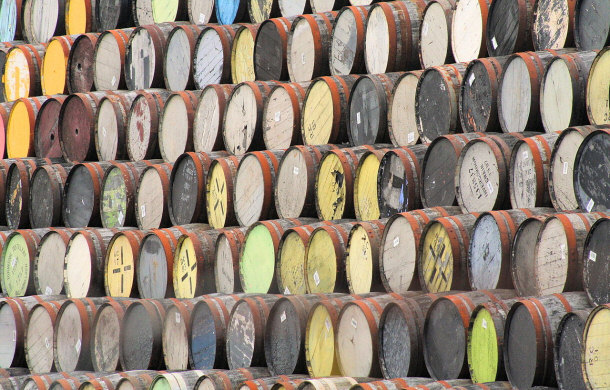
By John Haslam
via Wikimedia Commons
However, curing whiskey in barrels is not without its disadvantages. One of
them is the fact that when whiskey is stored in a barrel, at least 3-4% of it
will evaporate each year. This is what makes old whiskey so valuable.
Evaporation in the first year is generally the highest. It can be as high was 8
– 10%. After that, it levels off to the standard 3-4%. According to "The Angels
Share," good whiskey will lose about 30% of its starting volume before it is
time for it to be bottled and sold.
The term the Angels Share is actually in reference to the evaporation. While
there are a variety of accounts, the general story that relates to this term
comes from Ireland or Scotland. Both have similar variations. According to this
tale, the guardian angel of the whiskey maker had developed through great
trouble and fuss. The whiskey maker had a bad habit of almost getting himself in
trouble, and the angel was the one who made sure that it was just right.
Exhausted from a number of close encounters and dangerous escapades, the
guardian angel at last collapsed down in the cellar. While there, he decided to
wet his whistle with the whiskey, and he found that he was then strong enough to
continue with his task. From then on, he shared with all of the other guardian
angels, describing it as a perk to their tireless and often thankless job.
Brewing Vessels Containing Wash (Washbacks) for Single Malt
Scotch Production:
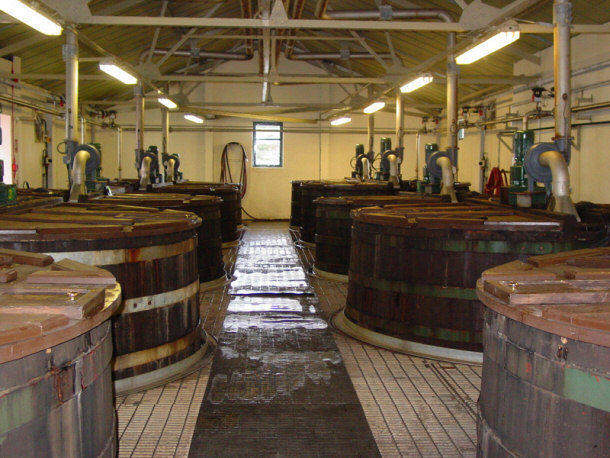
By Finlay McWalter
via Wikimedia Commons
The scientific reason that so much evaporates actually has to do with the
pores in the barrels. Oak barrels are quite porous. While they are not so porous
that they let the whiskey spill out, they are porous enough to let oxygen in.
The oxygen in term oxidizes within the barrel, and this results in the aging as
well as the evaporation.
12) Whiskey Should Not Be Taken with Ice
If you want to enjoy whiskey, you
must never add ice. Ice creates a number of problems when it comes to whiskey,
and not the least of these is that it dulls the flavor. According to "Facts
About Whiskey," published by Business Insider, ice dulls the flavor. Because the
temperature of the ice is so low, it inhibits the flavor by reducing the
temperature too far. This likewise freezes the distinctive aroma.
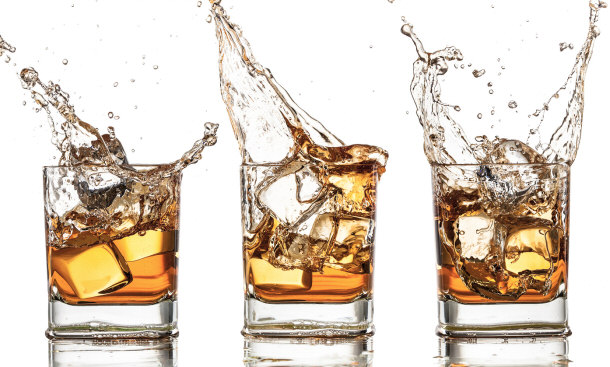
Since taking
it without anything is not considered the best way to drink it, the Modern
Gentleman recommends splashing a bit of water in. Soft spring water enhances
both the flavor and aroma. However, the Modern Gentleman warns against using tap
water. The high chlorine levels spoil the distinctive flavor.
11) The Color Concentration of a Whiskey Fire Demonstrates the Alcohol Density
The Scotch had a number of methods for determining whether their whiskey was
perfected. These weren't necessarily as simple as just drinking it to see if it
was good. Whiskey had to age a significant period of time. Even then, it had to
go through additional curing and distilling processes to make sure that it was
really good. According to "Facts About Whiskey," they determined that lighting a
sample of the Scotch on fire was the best way to determine whether the whiskey
had a sufficient alcohol content or too much.
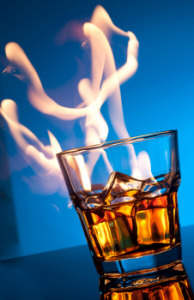
When set on fire, the flames should match the ideal color span of a bottle of
whiskey. The flames should be red and orange as time passes. According to
"Whiskey Facts," whiskey that burned too hot indicated a whiskey that had far
too much alcohol in it. Since there was nothing that they could do, the
manufacturers generally sold it at knock off prices to anyone who wanted it.
10) Whiskey Caused a Rebellion
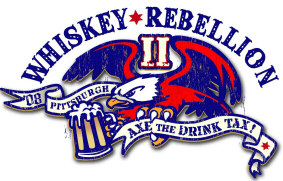 For quite some time in colonial America,
whiskey did not have any tax on it whatsoever. It even became used as a primary
means of bartering exchange. However, that was not to last. According to
"Shocking Facts About Whiskey," the newly freed America had to find a way to pay
off the war debt. Many of the states had refused to pay their bills, and the
federal government was left holding the bag. The taxpayers refused to pay the
money up. They insisted that this was precisely what they fought against in the
Revolution, and they could not be made to pay taxes. The distillers proved to be
some of the most vocal members of this group. For quite some time in colonial America,
whiskey did not have any tax on it whatsoever. It even became used as a primary
means of bartering exchange. However, that was not to last. According to
"Shocking Facts About Whiskey," the newly freed America had to find a way to pay
off the war debt. Many of the states had refused to pay their bills, and the
federal government was left holding the bag. The taxpayers refused to pay the
money up. They insisted that this was precisely what they fought against in the
Revolution, and they could not be made to pay taxes. The distillers proved to be
some of the most vocal members of this group.
George Washington near Fort Cumberland, Maryland Before
March into Pittsburgh:
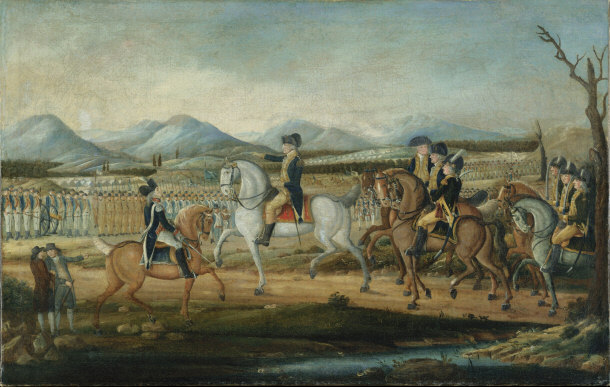
According to "The Whiskey Rebellion," a tax was levied against all whiskey
sales, including ones reached through bartering. The purpose was to raise funds
to pay off the debts. However, this did not go over well. Throughout
Pennsylvania, the state hardest hit, the townspeople and distillers revolted.
Over five hundred men attacked the tax inspector. President George Washington
sent out both a peace commissioner as well as a militia force. Before the
militia arrived, though, the rebels dispersed. No actual battle was fought. This
solidified the national government's ability to suppress resistance as well as
its ability to tax. While it still struggled to maintain its authority
initially, the tax on whiskey has remained constant ever since. It was
considered one of the easiest items to tax, and it was in fact the first tax
levied against a domestic product since the Revolution. There was one brief
period, though, under Thomas Jefferson where the tax was appealed, but later
laws placed it back on whiskey and all other alcoholic beverages as well.
9) There Are Approximately Seven Regions of Whiskey
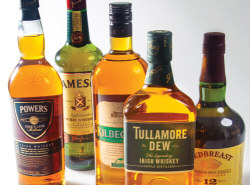 A number of different
whiskeys have formed over the years. However, according to Business Insider,
connoisseurs only recognize five regions. More lenient connoisseurs are willing
to admit that there might be seven. The first five regions include Scotch
Whisky, Bourbon Whiskey, Tennessee Whiskey, Canadian Whiskey, Irish Whiskey.
These are considered to be the best of the best. According to "Facts About
Whiskey," two other possible regions include New Zealand Whiskey and Japanese
Whiskey. Each of these different regions has their own secrets for making their
whiskey. Often times, this has just as much to do with the process that is used
to distill and cure the whiskey as it is to the ingredients involved in the
processing. Bourbon whiskey, for instance, is only distilled once as opposed to
the standard few times. This gives it a slightly richer and cloudier flavor. A number of different
whiskeys have formed over the years. However, according to Business Insider,
connoisseurs only recognize five regions. More lenient connoisseurs are willing
to admit that there might be seven. The first five regions include Scotch
Whisky, Bourbon Whiskey, Tennessee Whiskey, Canadian Whiskey, Irish Whiskey.
These are considered to be the best of the best. According to "Facts About
Whiskey," two other possible regions include New Zealand Whiskey and Japanese
Whiskey. Each of these different regions has their own secrets for making their
whiskey. Often times, this has just as much to do with the process that is used
to distill and cure the whiskey as it is to the ingredients involved in the
processing. Bourbon whiskey, for instance, is only distilled once as opposed to
the standard few times. This gives it a slightly richer and cloudier flavor.
Single Malt Scotch Regions:
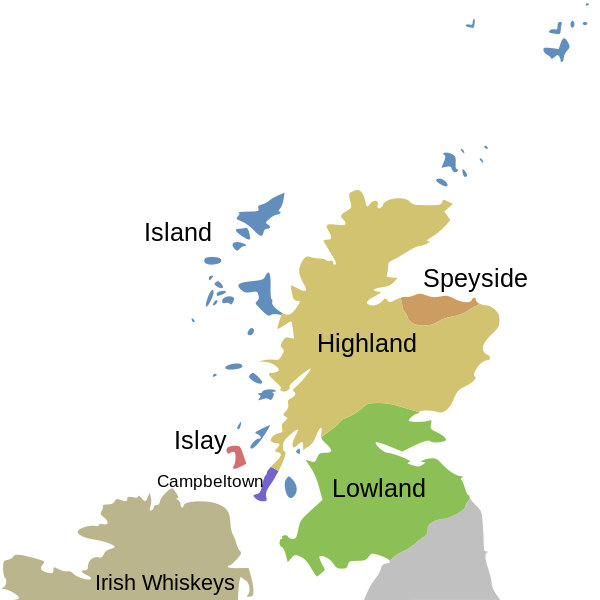
By Briangotts
via Wikimedia Commons
8) The Name for Whiskey Means "Water of Life"
The word "whiskey" has
developed significantly over the years. Originally, the Celts had a beverage
quite similar to whiskey that they referred to as uisge beatha. This was Gaelic
for "water of life." As the distillation process continued and the beliefs
surrounding the beverage's medicinal properties grew, more and more started
referring to it as uisge beatha. It also became known as aqua vitae in Latin.
Later on, it was shortened to "usge." It can also be spelled Whisky
instead of Whiskey.
Check Out on Amazon.com
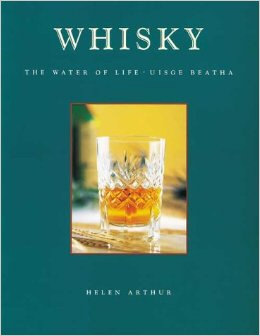
Eventually, even this changed into "usky,"
according to "The Etymology of Words." By this time, the language had changed so
much that people began to call it what it sounded like, and they changed the
spelling as well. The "New English Dictionary of English Principles" states that
soon the beverage became known simply as "whisky." That name has stuck ever
since, even though there are currently thousands of variations of whiskey in the
world.
7) Scotland Claims It Invented Whiskey
According to "Scotch Whisky: Water of
Life," the Scotch are the ones who invented whiskey. Actually, they will claim
that they invented both whiskey and whisky, but that the rest of the world can
make the whiskey, so long as they can make the whisky. According to tradition,
the monk St. Patrick brought the distillation process to Scotland from Ireland.
He and his monks used it in Scotland to help remedy the woes and the pains of
many. The very first distilleries in Europe were installed in monasteries.
Initially, they were used to distill wine, but in Scotland, the most plentiful
alcoholic beverage was the malt and barley beer. Since that was what was
available, that was what they used with their distillation processes.
Old Bushmills Distillery:
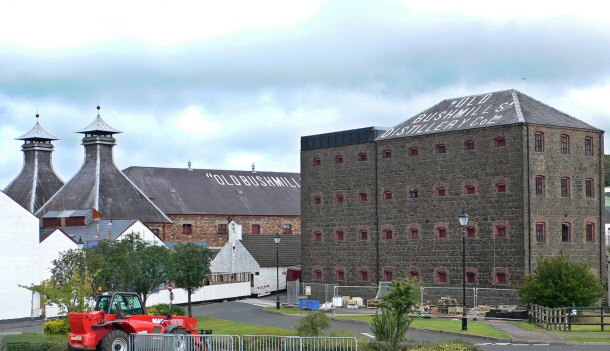
By Soerfm
via Wikimedia Commons
According to "The History of Whisky," the first explicit reference to whisky
came about in reference to an order from Friar John Cor. He requested eight
bolts of malt to make his "water of life." The climate and landscape of Scotland
made distilling and cultivation of whiskey significantly easier as opposed to
countries like Italy with longer warm periods and flat terrain in some regions.
The long periods of cold and the malt and barley proved to be excellent
ingredients for what would soon become Scotland's iconic drink.
The Scotch distinction between whiskey and whisky is actually the distinction
between Scotch and whiskey. Scotch, a single malt whiskey, can only be made in
Scotland. It is illegal to make it anywhere else in the world, and it has to be
made under the strictest standards. The term Scotch came to be used because it
was easier to understand than the slight difference in pronunciation for whiskey
and whisky.
Scotch Whisky Heritage Centre,
Edinburgh - Home of the Scotch Whisky Experience:
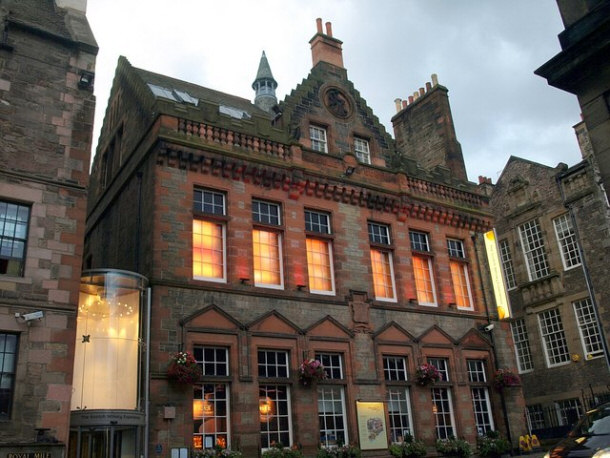
By Derek Harper
via Wikimedia Commons
During the Middle Ages and Renaissance, though, they were both referred to as
whisky at first. Scotland continued to hone in on its recipe. The monasteries
and the monks saw to most of these tasks. However, eventually King Henry VIII
dissolved all of the monasteries. The monks, now unemployed, began to distill
whiskey in their homes and sell it to stores and taverns, and thus, the tavern
favorite was released into the public.
6) The Oldest Bottle of Whiskey Was Found Bottled in Antarctica
Whiskey is
one of the few items that has been in every country in the world and used in
every continent as well. Antarctica is generally left on this list since most
people generally don't go there. But, according to Whiskey Facts, whiskey was
one of the few beverages that could travel to Antarctica. Ernest Shackleton took
a bottle there. He also left it behind. This was discovered in 2010. According
to Discovery, the expedition that found it brought it back.
One of Shackleton's Original Bottles:
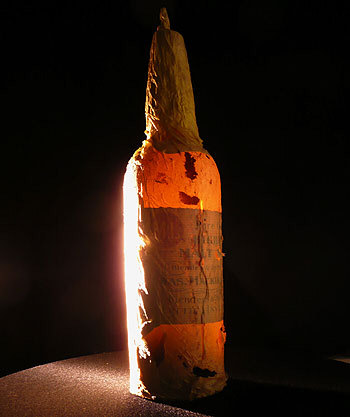
They were
tremendously surprised to discover that the whiskey had not shattered. According
to Whiskey Facts, whiskey can remain unfrozen at sub zero temperatures for quite
some time. However, at this point, the whiskey had frozen gradually. The whiskey
turned out to be over one hundred years old. After it was thawed out, it was
uncorked and prepared for celebration.
5) Someone Might Have Found the Original Jack Daniels' Recipe in Wales
According to the Telegraph, a middle aged man discovered an 1853 recipe from his
Grandmother Daniels. He also found a number of references that supposedly
indicated that this recipe was in fact the legendary Jack Daniels' recipe.
However, the Jack Daniels official website and press release denied this
possibility.
Jack Daniels Distillery Visitor Center Entrance Lynchburg,
TN:
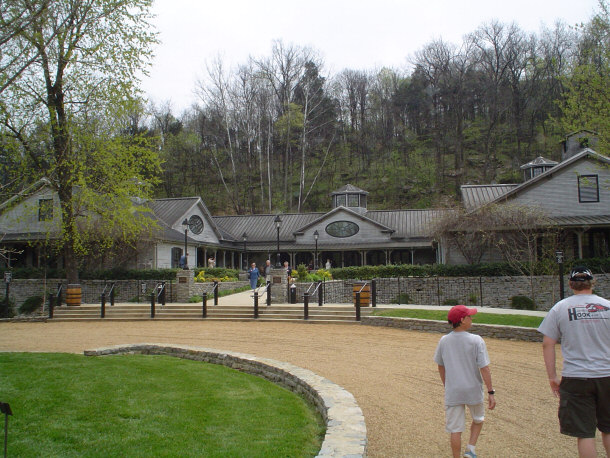
By Ben Jacobson
via Wikimedia Commons
They insisted that the dates did not match the stories that they
knew of Jack Daniels. Additionally, they claimed that Jack Daniel learned how to
make whiskey from a Lutheran minister instead of from a grandmother's recipe.
The website goes on to say that such sightings and reports are not uncommon
since the Jack Daniels' story is one that still inspires the imagination.
Jack Daniels Statue in front of Subterranean Fresh Water
Spring at Lynchburg Distillery:
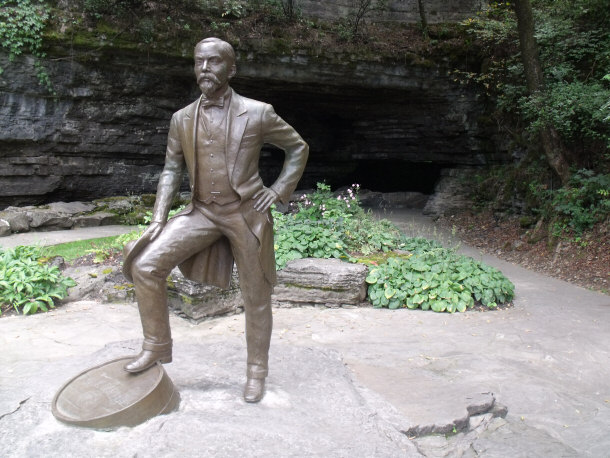
By ZachJBeavers
via Wikimedia Commons
4) Whiskey Actually Started Out in Babylon and Mesopotamia
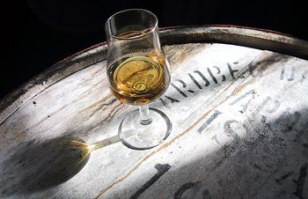 This is not
something that you should say in a pub in Scotland, Ireland, Tennessee,
Australia, or any of the other primary regions for whiskey. However, historians
believe that the key development to whiskey actually started back in the
Babylonian time in Mesopotamia. The actual whiskey recipe, fortunately, did not
start at this time. What did begin here was the distillation process. This is not
something that you should say in a pub in Scotland, Ireland, Tennessee,
Australia, or any of the other primary regions for whiskey. However, historians
believe that the key development to whiskey actually started back in the
Babylonian time in Mesopotamia. The actual whiskey recipe, fortunately, did not
start at this time. What did begin here was the distillation process.
According to "The Ancient Cultures," the Babylonians were among the first to
begin development of distillation processes necessary for perfume. They also
played a central role in the development of alcoholic beverages. The purposes of
both of these was initially intended for medicinal and health related reasons.
The waters of Mesopotamia, though not generally toxic, were not always good
particularly in the drier months. Most of the time, those who were not fortunate
enough to live near rivers, had to get their water from cisterns. In getting
their water from cisterns, the water would often become quite stagnant during
the late summer months. Although their doctors did not know the reasons why many
became ill, they did know that the bad water caused it. So they started trying
to find ways to kill whatever was in the water and make it safe to drink. While
they were not completely successful, "Babylonian Medicine" states that they did
come up with a number of spiced wines and beverages that made it easier to drink
without getting sick.
Plan of Babylon:

By Radomil
via Wikimedia Commons
The filtration process that the Babylonians used was spread out throughout
the world, primarily focusing up toward the north. Eventually, some monks
discovered it, and they began to use it to distill and develop their alcoholic
beverages. It made for a much stronger flavor as well as better quality control.
3) Whiskey Was Used to Help Cure a Number of Ailments
According to "The
History of Scotch Whiskey," Whiskey was initially developed as a medicinal
product. It received numerous commendations and references from a number of
doctors and practitioners of that time. In fact, infants were in Scotland often
received a full draught of whiskey as their first drink to make them strong and
keep them warm. While whiskey was believed to extend life, it was used primarily
as a relief agent. Doctors used it to treat palsy, colic, the flu, colds, and
smallpox.
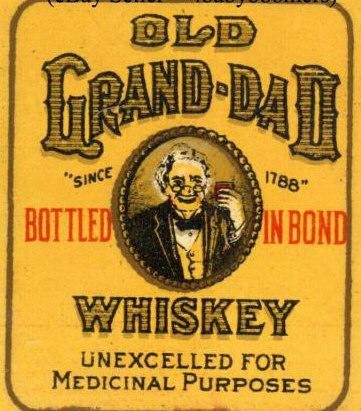
Despite starting out this way, "The Culture of Whiskey" reveals that it soon
became used just as much as a part of social life. It was incorporated into the
drink of hello and the drink of good bye and the drink of quite a bit in
between. Part of this came about because of the long winters in Scotland. To
keep warm during the winters and keep the blood moving, families started sharing
whiskey. From there, it went on to become a tradition in its own rite.
Even in modern day, whiskey does have certain medicinal purposes. According
to Whiskey Facts, it helps to keep the metabolism going, and it has also been
found to prevent strokes and dementia. Over excessive consumption negates many
of these benefits. However, it also helps to cleanse the arteries and can
increase the levels of good cholesterol. Research is being conducted to
determine whether it truly is a good agent in the fight against cancer. Whiskey
lovers, of course, are happy to hear this.
2) Some Whiskey Was Legal During Prohibition
During Prohibition, most
alcohol was illegal. However, according to "Strange Facts about Prohibition,"
certain alcoholic beverages were allowed so long as they were prescribed by a
doctor. Whiskey was one of these beverages. Patients in need could obtain a
flask or two from their doctor to assist in a number of ailments. Surprisingly,
it was not even necessary for them to be adults. "Old America Home Remedies"
states that it was a long and old Irish and Scottish custom that led parents to
rub whiskey on the gums of their teething children.
Pro-Prohibition Cartoon by the Ku Klux Klan:

While most Americans had
shied away from the practice of feeding an infant whiskey for his first meal,
whiskey was still given to children to help control pain and to improve their
immune systems.
1) Chill Filtration is Necessary to Keep the Whiskey Clear
|
Chill Filtration Room:
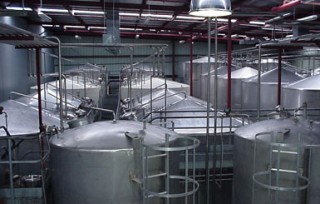
|
Whiskey is not
supposed to be a cloudy drink, at least that's what everyone thinks. After all,
in restaurants and movies, it always looks clear and golden. However, whiskey is
not usually that way. In fact, "Chill Filtration" an article in "Whiskey Basics"
states that in the Old West and the like, it was not uncommon for whiskey to be
cloudy or hazy.
The chill filtration process requires cooling the Whiskey to zero degrees or
less and then sending it through an absorption filter. This has to be done at a
very minute level. It does not make the alcohol taste better. However, according
to "Chill Filtration Basics," chilling reduces fatty acids, esters, and proteins
as well. Blended whiskeys have to be cooled at even lower levels. To accomplish
the chill filtration, the alcohol volume must be brought down to 46% of certain
key components.
Certain distilleries refuse to use this process despite the cosmetic appeal,
though. Aberlour Distillery, for instance, claims that it has never used a chill
filtration process and that it never will. It developed its marketing campaign
to describe its whiskey as being smoky. The added benefit, of course, is that it
is also significantly less expensive.
Drinks
15 Surprising Facts About Soda
15 Little Known Facts About Coca-Cola
10 Surprising Facts About the History of Brewing Beer
Top 15 Best American Beer Festivals
Top 15 Coca-Cola Myths Debunked
15 Common Wine Myths and Their Realities
15 Fascinating Facts in the World of Whiskey |